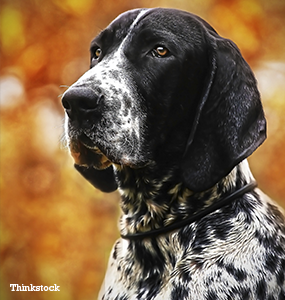Background
Originating in Louisiana during the 18th century, the Bluetick Coonhound is a descendant of the French Staghound (who hails from southwest France), the English Foxhound, the Cur Dog, the American Foxhound, and the Black and Tan Virginia Foxhound.
Bluetick Coonhounds were originally members of the English Coonhound breed. Bluetick breeders broke away from the English Coonhound in 1945 because they desired a different kind of dog. The breed they desired would have a slower style of tracking and a “colder” nose. Having a “cold nose” meant that the Bluetick could pick up and follow an animal’s trail, even if that trail was old.
The Bluetick Coonhound was recognized by the American Kennel Club in 2009.
Sizing up
- Weight: 45 to 80 lbs.
- Height: 21 to 27 inches
- Coat: Short, polished and somewhat coarse in texture
- Color: Blue ticked or blue ticked with tan
- Life expectancy: 12 to 14 years
What’s the Bluetick Coonhound like?
The Bluetick Coonhound is very affectionate towards his family, loves children, and is well suited to live almost anywhere; although, his bark is very long and loud so keep that in mind if you’re living in an apartment. A bigger dog like the Bluetick will need plenty of exercise: fetching, walking, or even a hiking will keep him happy.
Bluetick Coonhounds can sometimes be a challenge to train. It’s very important to start training sessions as soon as you bring them home. It’s also very important to be consistent during the training sessions and always use positive reinforcement: throw your Coonhound a treat when he’s done a good job.
Having a short coat makes the grooming process very easy. All he’ll need is a weekly brushing, preferably done with a rubber brush to remove dead hair and to keep his coat nice and glossy.
Health
The Bluetick Coonhound is generally a healthy breed but you should always watch for the following conditions:
Bloat is a condition that can occur while the dog is digesting. Something goes wrong, causing gases to build up in the stomach and cutting off the circulation of blood to and from the heart.
Hip dysplasia is one of the most common diseases seen in dogs, with larger breeds being the most commonly affected by it. It’s ultimately a malfunction of the hip joints causing them not to develop normally. Over time the hip joints deteriorate resulting in a loss of function.
- Lysosomal Storage Disease
Lysosomal storage disease is a genetic disease and is caused by an inadequacy of enzymes that are crucial to complete metabolic functions. It usually is seen in puppies so always check with your breeder and get relevant health documents.
Takeaway Points
- The Bluetick Coonhound is an excellent hunting dog.
- The Bluetick Coonhound is easy to groom.
- The Bluetick Coonhound is highly adaptable to different living quarters.
- The Bluetick Coonhound needs to begin training as soon as you bring him home.
If you have any questions or concerns, you should always visit or call your veterinarian -- they are your best resource to ensure the health and well-being of your pets.
